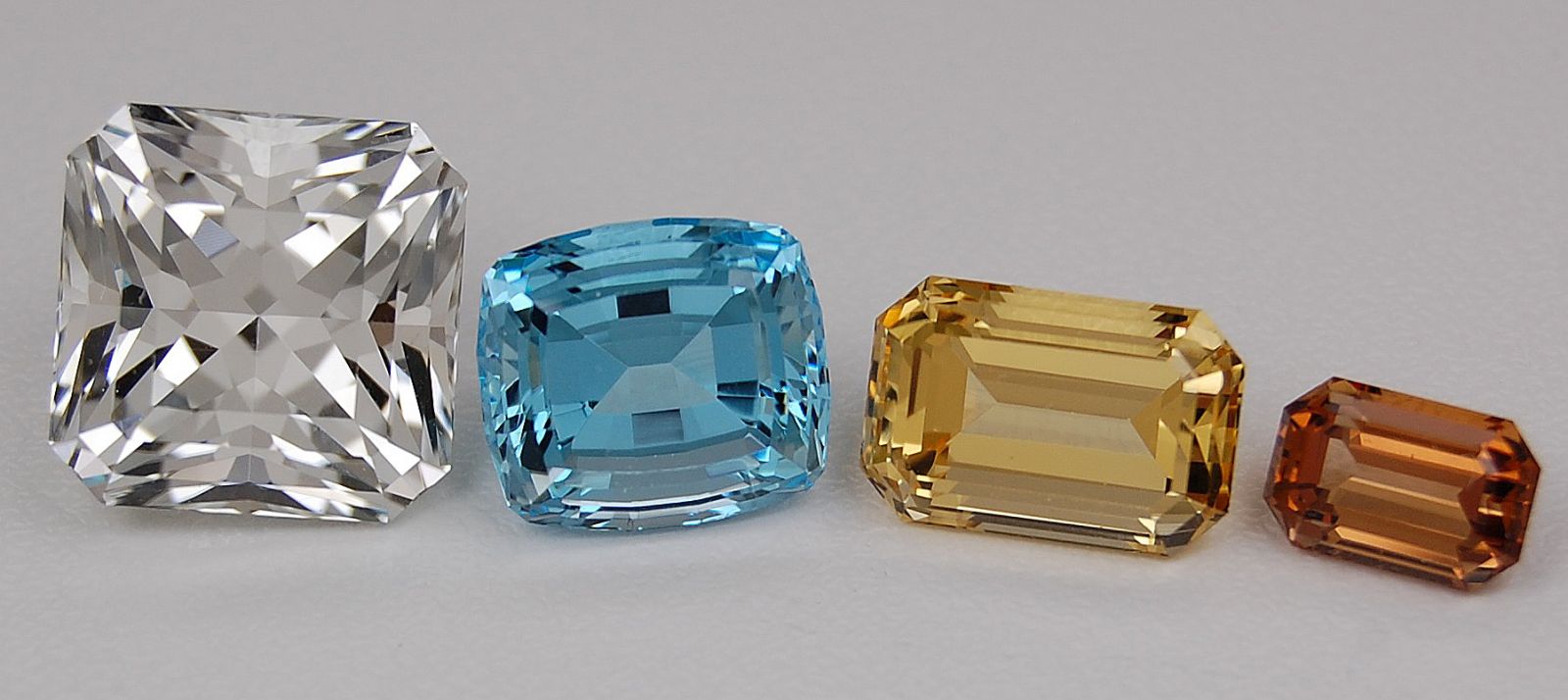
Introduction: Topaz is a mineral species with many color varieties. Pictured above, from left to right, 24.10 ct colorless square radiant, 12.68 ct blue cushion, 9.65 ct yellow emerald cut and 3.50 ct brownish-orange emerald cut.
Colors: colorless, yellow, orange, brown, pink, purple and blue. Varieties are simply referred to by color, that is, blue topaz, pink topaz, etc. The variety known as imperial topaz must have an orange body color with a pink secondary tone.
Clarity: Topaz is of Type I clarity. By definition, gems of this type grow extremely clean in nature and usually have no eye visible inclusions. Two phase inclusions consisting of liquid and a gas bubble as well as three phase inclusions are commonly found.
Stone Sizes: Colorless, brown and blue topazes have been cut in the thousands of carats. For use in jewelry, blues are less than 50 carats while typical sizes for yellow, orange, imperial and pink are less than 10 carats with an occasional stone in the 20 carat range.
Localities:
-Brazil: Colorless, yellow, orange and imperial colors are well documented from several localities in the country. Natural, light blues are also found on occasion.
-Pakistan: Fine pinks from Ghundao Hill near Katlang; light to medium sherry colored topaz is found in several areas.
-Nigeria, Madagascar, Russia: Colorless crystals are found, sometimes in large sizes, from Nigeria and Madagascar. Russia is well known as a source of pinks and large browns although the availability of pink is rare.
Mexico, Utah: Brownish to sherry colored topaz crystals are found in fine crystals but the color is not stable to light, fading within a relatively short period of time.
Sri Lanka, Burma, Australia, Namibia
United Sates: Colorado, Texas and New Hampshire supply the local collector markets but not available in commercial quantities.
Treatments:
-Heating (H) of orange crystals from Brazil that contain chromium will turn pink. The resulting color is stable and undetectable
-Irradiation (R) of colorless topaz is commonly done to change the color to brown as a first step in the production of treated blue topaz. The second step involves heating (H) to turn to blue. Although blue topaz can occur naturally, medium to dark blue colors rarely, if ever, occur in nature. The resulting color is stable.
Gemology:
-Refractive Index: 1.619-1.627 (+/-0.010)
-Birefringence: 0.008 to 0.010
-Optic Character: Doubly refractive, biaxial positive
-Dispersion: 0.014
-Specific Gravity: 3.53 (+/-0.04)
-Hardness: 8
Toughness: poor due to cleavage
-Chemical Composition: Al2(F,OH)2SiO4
-Cause of Color:
Pink, red - chromium
Blue, yellow, brown - various color centers
Orange - color centers and chromium
-Fluorescence: Blue and colorless are inert to weak yellow or green (LW) and weaker (SW). Yellows, browns, pinks and reds are weak to moderate orange-yellow (LW); weaker in (SW)
-Cleavage: perfect in one direction
-Phenomena: Chatoyancy (rare)
Name: Topaz may derive from the Sanskrit word tapas, meaning fire, in allusion to the orange color; alternatively from the name of an island in the Red Sea called topazos, meaning to seek.
Dates: Topaz is the birthstone for the month of November. Blue topaz is the 4th anniversary stone and imperial topaz is for the 23rd anniversary.
Care: The ultrasonic or steamer should never be used. Warm, soapy water is safe.
To see available topaz, click here.
